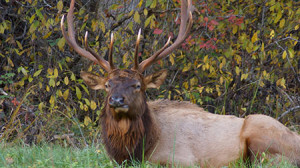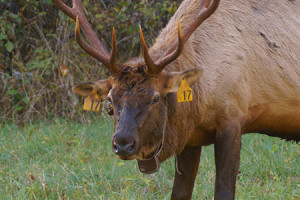
Photo: Andrew Home
Today, if you were tovisit the wilderness area’s of Kentucky near the Tennessee border, you may hear an unexpected sound, the sound of a bugling bull elk. Joseph Love’s article, Reintroducing Elk to the Great Smokey Mountains, examines the reintroduction of this recently reintroduced species. After being extirpated in the late 1800’s, elk are being reintroduced into the United States’ eastern wilderness areas. In 1997, Manitoban elk (Cervus elaphus manitobensis), were successfully transplanted in place of their predecessors, the eastern elk (Cervus elaphus canadensis), a species extremely prevalent in the times of the early settlers.

Photo: Joseph Love
Elk reintroduction has had a positive impact on the economy to the area around the Land Between the Lakes Recreation Area in Kentucky where these large ungulates were transplanted. Many tourists and wildlife enthusiasts come to the area to see these hoofed mammals. The surge in guests has allowed the park service to hire the necessary staff and acquire the funding to perform park maintenance projects.
Although the reintroduction project has benefited the local economy, there are some glaring downsides. If elk are reintroduced with too small a number of individuals, the animals are extremely susceptible to a brain eating worm passed on by white-tailed deer. To avoid the wipeout of elk from this disease, Kentucky’s initial transplant of elk consisted of 1,800 individuals, a number that rose to 4,500 individuals in just seven years. The remote nature preserve in Kentucky is a perfect habitat for these elk, but with the high elk numbers, elk are spilling into Virginia where the animals are becoming too accustomed to humans and where there is open hunting season on elk. To keep tabs on elk population behaviors and movements, all elk in the area are tagged, collared, and consistently monitored.
The spread of disease and the encounters between elk and humans are not the only potential repercussions of this reintroduction. Elk is a species not seen by the eastern forests for more than 100 years and the animals’ impacts on the ecosystem are unforeseen and potentially damaging. In the beginning, elk foraging was sustainable enough to stimulate vegetation growth, in turn benefiting other species in the ecosystem. In recent years, elk have realized the abundance of food available in these eastern forests, such as acorns, so the prolonged effects of their grazing may not be apparent for several more years. Wildlife biologist of the Cataloochee Valley, Joe Yarkovich, says it may take 10 to 15 years to see the true effects these elk are having on the ecosystem. Hopefully, by the time biologists realize the effects elk are having on the surrounding ecosystem, the effects will not be negative or irreversible.
Elk reintroduction in the Smokies is in its early stages. If population numbers continue to be stable and detrimental ecosystem changes are kept at bay, the reintroduction of this species will be seen as a success for conservationists. With any species management, there is always the discussion of how much management is too much management. Does collaring and tagging these animals make them “wild” animals or are we just deeming them to be our cattle of the forests? The question still lies on whether or not humans can coexist and adapt to having these large, grazing ungulates inhabit the land and let the elk roam free.
Link to article: http://www.americanforests.org/magazine/article/reintroducing-elk-to-the-great-smokey-mountains/
MP

